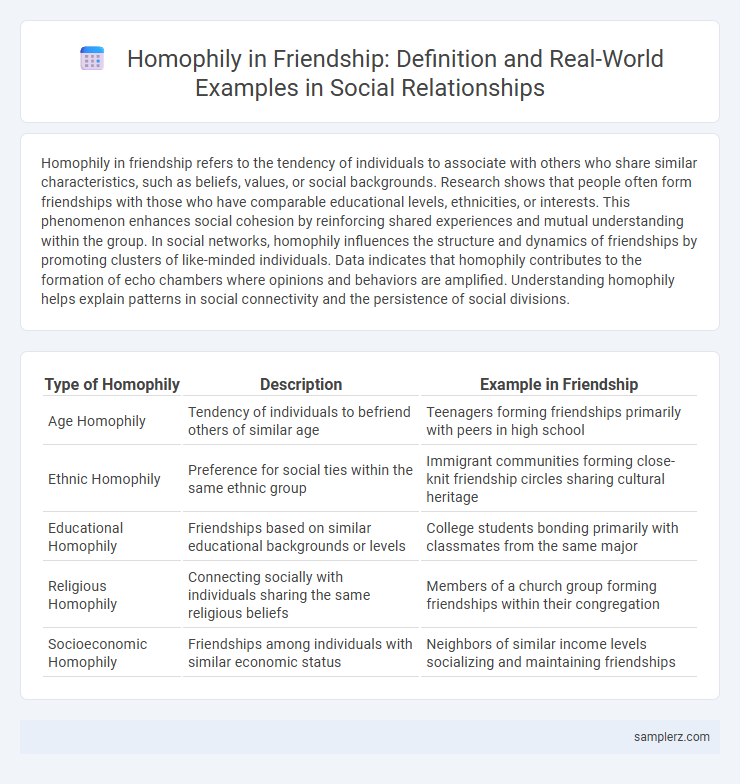Homophily in friendship refers to the tendency of individuals to associate with others who share similar characteristics, such as beliefs, values, or social backgrounds. Research shows that people often form friendships with those who have comparable educational levels, ethnicities, or interests. This phenomenon enhances social cohesion by reinforcing shared experiences and mutual understanding within the group. In social networks, homophily influences the structure and dynamics of friendships by promoting clusters of like-minded individuals. Data indicates that homophily contributes to the formation of echo chambers where opinions and behaviors are amplified. Understanding homophily helps explain patterns in social connectivity and the persistence of social divisions.
Table of Comparison
| Type of Homophily | Description | Example in Friendship |
|---|---|---|
| Age Homophily | Tendency of individuals to befriend others of similar age | Teenagers forming friendships primarily with peers in high school |
| Ethnic Homophily | Preference for social ties within the same ethnic group | Immigrant communities forming close-knit friendship circles sharing cultural heritage |
| Educational Homophily | Friendships based on similar educational backgrounds or levels | College students bonding primarily with classmates from the same major |
| Religious Homophily | Connecting socially with individuals sharing the same religious beliefs | Members of a church group forming friendships within their congregation |
| Socioeconomic Homophily | Friendships among individuals with similar economic status | Neighbors of similar income levels socializing and maintaining friendships |
Shared Interests: The Foundation of Homophilic Friendships
Shared interests form the foundation of homophilic friendships by creating common ground that fosters strong social bonds. People who enjoy similar hobbies, such as sports, music, or gaming, often cluster together, enhancing mutual understanding and trust. This alignment of preferences not only strengthens interpersonal connections but also reinforces social group cohesion through frequent, meaningful interactions.
Educational Background and Friendship Formation
Friendship formation often reflects homophily, where individuals with similar educational backgrounds tend to bond more easily due to shared experiences and values. Studies show that students from the same academic programs are more likely to develop close friendships, enhancing communication and collaboration. This educational homophily influences social networks by creating clusters of peers with comparable knowledge and learning interests.
Cultural Similarity as a Predictor of Bonds
Cultural similarity plays a significant role in forming and maintaining friendships, as shared language, traditions, and values foster mutual understanding and trust. Studies in social networks reveal that individuals with similar cultural backgrounds are more likely to develop strong, lasting bonds due to aligned social norms and communication styles. This homophily effect enhances group cohesion and facilitates smoother interpersonal interactions within diverse communities.
The Role of Socioeconomic Status in Friend Choice
Socioeconomic status significantly influences friend choice through homophily, where individuals tend to form friendships with others sharing similar income, education, and occupational backgrounds. Studies indicate that people from higher socioeconomic classes often cluster together, reinforcing social networks that provide access to exclusive resources and opportunities. This pattern limits cross-class interactions and perpetuates social inequalities within friendship circles.
Age Homophily: Connecting Through Generational Similarity
Age homophily strongly influences friendship formation as individuals tend to connect with peers within their own age group, fostering shared experiences and cultural references. Studies highlight that generational similarity enhances communication ease and emotional understanding, which deepens social bonds. This pattern is evident in diverse settings, from schools to workplaces, where age-based clustering supports social cohesion and mutual support.
Gender Homophily and Social Circles
Gender homophily in friendship manifests when individuals predominantly form social circles with others of the same gender, reinforcing shared interests and communication styles. Research shows male and female friendship groups often develop distinct norms and activities, influencing social cohesion and identity. These gender-specific social networks contribute to the maintenance of homophilous ties, shaping social interaction patterns and community structures.
Political Alignment and Friendship Clusters
Friendship clusters often form around shared political alignment, demonstrating homophily as individuals preferentially connect with others who hold similar partisan beliefs. Studies show that these politically homogeneous networks reinforce ideological conformity and reduce exposure to diverse viewpoints. This pattern intensifies echo chambers, influencing social cohesion and political polarization within communities.
Linguistic Homophily: Language as a Friendship Bridge
Linguistic homophily occurs when individuals form friendships based on shared language or dialect, enhancing mutual understanding and social cohesion. For example, bilingual students often bond more closely with peers who speak the same native language, facilitating smoother communication and cultural exchange. This phenomenon strengthens social networks by reinforcing common linguistic identities and fostering trust among group members.
Racial and Ethnic Homophily in Social Networks
Racial and ethnic homophily in social networks refers to the tendency of individuals to form friendships and social ties with others who share similar racial and ethnic backgrounds. This phenomenon is extensively documented in sociological studies, revealing that people often cluster within racially and ethnically homogeneous groups, which influences access to resources, social support, and information flow. Such homophily impacts network structures and perpetuates social boundaries, shaping patterns of social interaction and community formation.
Religious Affiliation and the Creation of Close Friendships
Homophily significantly influences friendship formation, as individuals with the same religious affiliation are more likely to develop close friendships due to shared values and beliefs. Studies show that religious homophily fosters trust and social support, enhancing the depth of interpersonal connections within faith-based communities. This dynamic is evident across diverse religious groups, where common rituals and moral frameworks create a strong foundation for lasting friendships.

example of homophily in friendship Infographic
 samplerz.com
samplerz.com